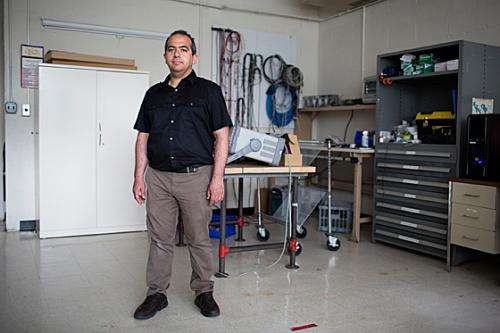On the hunt for neutrinos: Physicist seeks new ways to detect and measure the elusive particles

Every second, trillions of particles called neutrinos pass through your body. These particles have a mass so tiny it has never been measured, and they interact so weakly with other matter that it is nearly impossible to detect them, making it very difficult to study their behavior.
Since arriving at MIT in 2005, Joseph Formaggio, an associate professor of physics, has sought new ways to measure the mass of neutrinos. Nailing down that value—and answering questions such as whether neutrinos are identical to antineutrinos—could help scientists refine the Standard Model of particle physics, which outlines the 16 types of subatomic particles (including the three neutrinos) that physicists have identified.
Those discoveries could also shed light on why there is more matter than antimatter in the universe, even though they were formed in equal amounts during the Big Bang.
"There are big questions that we still haven't answered, all centered around this little particle. It's not just measuring some numbers; it's really about understanding the nature of the equation that explains particle physics. That's really exciting," Formaggio says.
Paradigm shift
Formaggio, the only child of Italian immigrants, was the first in his family to attend college. Born in New York City, he spent part of his childhood in Sicily, his parents' homeland, before returning to New York. From an early age, he was interested in science, especially physics and math.
At Yale University, he studied physics but was also interested in creative writing. The summer after his freshman year, in search of a summer job, he "called every publishing house in New York City, all of which resoundingly rejected me," he says. However, his call to the Yale physics department yielded an immediate offer to work with a group that was doing research at the Collider Detector at Fermilab. That led to a senior thesis characterizing the excited states of the upsilon particle, which had recently been discovered.
As a student, Formaggio was drawn to both particle physics and astrophysics. At Columbia University, where he earned his PhD, he started working in an astrophysics group that was studying dark matter. Neutrinos were then thought to be a prime candidate for dark matter, and the mysterious particles intrigued Formaggio. He eventually joined a neutrino research group at Columbia, which included Janet Conrad, a professor who is now at MIT.
While a postdoc at the University of Washington, Formaggio participated in experiments at the Sudbury Neutrino Observatory (SNO), located in a Canadian nickel mine some 6,800 feet underground. Those were the first experiments to show definitively that neutrinos have mass—albeit a very tiny mass.
Until then, "there were definitely hints that neutrinos undergo this process called oscillation where they transmute from one type to another, which is a signature for mass, but all the evidence was sort of murky and not quite definitive," Formaggio says.
The SNO experiments revealed that there are three "flavors" of neutrino that can morph from one to the other. Those experiments "basically put the nail in the coffin and said that neutrinos change flavors, so they must have mass," Formaggio says. "It was a big paradigm shift in thinking about neutrinos, because the Standard Model of particle physics wants neutrinos to be massless, and the fact that they're not means we don't understand it at some very deep level."
Another possible discovery that could throw a wrench into the Standard Model is the existence of a fourth type of neutrino. There have been hints of such a particle but no definitive observation yet. "If you put in four neutrinos, the Standard Model is done," Formaggio says, "but we're not there yet."
'A giant electromagnetic problem'
In his current work, Formaggio is focused on trying to measure the mass of neutrinos. In one approach, he is working with an international team on a detector called KATRIN, located in a small town in southwest Germany. This detector, about the size of a large hangar, is filled with tritium, an unstable radioactive isotope. When tritium decays, it produces neutrinos and electrons. By measuring the energy of the electron released during the decay, physicists hope to be able to calculate the mass of the neutrino—an approach based on Einstein's E=mc2 equation.
"Because energy is conserved, if you know how much you started out with and how much the electron took away, you can figure out how much the neutrino weighs," Formaggio says. "It's a very hard measurement but I like it because the experiment is a giant electromagnetic problem."
The KATRIN detector is under construction and scheduled to begin taking data within the next two years. Formaggio is also developing another tritium detector, known as Project 8, which uses the radio frequency of electrons to measure their energies.
Formaggio hopes that one day, tritium-based detectors could be used to find neutrinos still lingering from the Big Bang, which would require even larger quantities of tritium.
"There are many holy grails in physics, and finding those neutrinos is definitely one of them. People look at the light from the Big Bang, but that's actually closer to 300,000 years old, or thereabouts. Neutrinos from the Big Bang have been around since the first second of the universe," Formaggio says.
Provided by Massachusetts Institute of Technology
This story is republished courtesy of MIT News (web.mit.edu/newsoffice/), a popular site that covers news about MIT research, innovation and teaching.




















